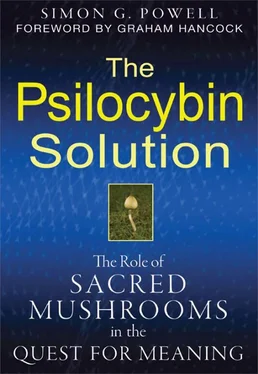In effect, Wasson’s Life article was timed to coincide with the release of his magnum opus two-volume book Mushrooms, Russia and History, cowritten with his wife, Valentina. This work fully reveals the extent of Wasson’s long-standing interest in the cultural use of fungi and how he finally came to be at the door of perception marked psilocybin .
With only 512 handcrafted copies luxuriously bound and printed, Mushrooms, Russia and History stands as a rare piece of art. Indeed, by the late 1970s its value had reached some $2,500, making it the most valuable book in existence at that time whose author was still alive. It is a highly polished book, written in a lively style that reflects the love of ethnomycology borne by the Wassons. It represents the distilled wisdom drawn from their extensive studies into the role that various species of mushroom played in different cultures, and it culminates in their discovery of the sacred mushroom ceremonies still being conducted in Mexico, a discovery important enough to warrant the further account in the more accessible pages of Life magazine.
The event that originally launched the Wassons on their mushroom crusade was simple, almost trivial, yet it was enough to provoke them into a three-decade-long bout of invaluable research. The Wassons married in 1927, and one day during their honeymoon they decided to take a casual stroll in the Catskill Mountains of New York. At some stage, Valentina, who was Russian by birth, stopped to pick wild mushrooms, delighting in such a fortuitous find. Her husband, on the other hand, being true to his Anglo-Saxon heritage, was appalled at his wife’s avid interest in lethal fungal abominations, especially since she planned to cook and eat them later. After all, were not all fungal growths poisonous toadstools to be avoided like the plague? With growing dismay, Gordon Wasson imagined himself waking up the next morning with a corpse instead of a wife.
This pronounced and deep-rooted difference in attitude between the two of them over the culinary virtues of fungi led them to suspect a cultural rift, that there were mycophobic peoples (sensible mushroom haters like the Anglo-Saxons) and mycophilic peoples (reckless mushroom aficionados like the Russians). Furthermore, the Wassons reasoned that there must be a historical reason for these diametrically opposed traditions, due not to something like food availability, but rather to cultural and psychological factors. Thus began the Wassons’ academic quest to explore this strange cultural anomaly. From the start both figured that religion somehow played a causal role.
Their intuition proved correct. Research soon unearthed the Siberian cultural history of the Amanita muscaria mushroom, also known as fly agaric, that extraordinary bright red and white-spotted autumnal fungus found throughout the Northern Hemisphere and often charmingly depicted in the illustrations adorning the pages of children’s books. Indeed, it has been suggested that Lewis Carroll was influenced by knowledge of the Siberian use of the fly agaric and used the information to great effect in his book Alice’s Adventures in Wonderland, in which, you might recall, Alice nibbles on a mushroom that subsequently alters her size.
As we shall see, compared with the psilocybin mushroom, the fly agaric’s psychoactivity rates a poor second, though it is potentially entheogenic due to the presence of an alkaloid named muscimol. Despite muscimol’s entheogenic inferiority to psilocybin, the cultural role and use of the fly agaric mushroom among Siberian shamans is beyond dispute, and the Wassons uncovered a wealth of literature testifying to this fact. The fly agaric mushroom proved to be a link to primitive religion just as the Wassons had originally foreseen, and it soon became clear to them that psychoactive fungi were no small feature of cultural history.
Echoes of a Shamanic Beat
Since the time of Tsar Peter the Great (1672–1725), the Kamchatka Peninsula, the easternmost part of Russian Siberia, was visited by travelers, political exiles, explorers, fur traders, and anthropologists. All were to bear witness to the nomadic reindeer herders who ritually ingested fly agaric mushrooms (their only intoxicant) in order to obtain contact with the spiritual dimension. The word shaman itself derives from the Siberian Tungus saman, which means “diviner,” “magician,” “doctor,” “creator of ecstasy,” “the mediator between the human world and the supernatural world.”
The Siberian fly agaric user would sun-dry the mushrooms and later ingest them either alone or mixed with milk or water. If taken alone, the mushroom would first be moistened in the mouths of women, who would produce a kind of pellet for the shaman to swallow.
The effects of consuming this mushroom included convulsions, delirium, visual hallucinations, perceptual distortions of size, feelings of superhuman strength, and a perceived contact with a numinous dimension, this last effect being the most important for the practicing shaman, whose predominant function was to access the spiritual realm to attain supramundane knowledge for the good health of his or her tribe.
The most bizarre aspect of this shamanic tradition, however, was the habit of urine drinking. Somehow, the Siberians discovered that the active ingredient of the mushroom passed through the body without being metabolized and that drinking fly-agaric-spiked urine could prolong intoxication. Possibly the Siberians learned of this odd fact by observing reindeer, which not only reputedly eat the fly agaric themselves with much gusto, but also have an equal passion for human urine, so much so that Siberian reindeer herders considered it dangerous to pee out in the open!
The rather disturbing and unpalatable practice of drinking psychoactive urine attained great significance in Wasson’s later work in the 1960s, as urine drinking is mentioned in the Rig-Veda, the ancient religious scripture of India. Written in Sanskrit and derived from the oral traditions of the Indo-Europeans who migrated down into the Indus Valley some three and a half thousand years ago, the Rig-Veda eventually went on to influence the development of Hinduism.
Of the one thousand holy hymns in the Rig-Veda, more than one hundred are dedicated solely to the divine plant Soma and its spectacular psychological effects. Because urine drinking is clearly alluded to in these hymns deifying Soma, Wasson came to the conclusion that the fly agaric mushroom was the sacred Soma worshipped by the ancient Indo-Europeans. Indeed, in parts of India, followers of the Vedic tradition still perform a religious ceremony in which Soma is ingested, only they now utilize an inactive surrogate species of plant. Wasson’s identification of Soma was, at the time he made the claim, one of only a handful of serious attempts to explore and name the legendary Soma plant. To this day his identification is considered plausible by many Vedic scholars.
The shamanic use of fly agaric mushrooms by primitive Siberians seemed to date far back in history, as various legends spoke of its mythical origins. For instance, a Koryak legend tells of a hero named Big Raven who was able to attain immense strength by eating spirits given to him by the god Vahiyinin—the god of existence. By spitting upon the earth, Vahiyinin caused the necessary spirits to grow, these being fly agaric mushrooms with their ability to provide supernatural strength and wisdom.
The Wassons theorized that it was this archaic shamanic practice of fly agaric ingestion, so well reflected in legend and mythology, that eventually led to the mycophobic pre-Christian taboos against eating mushrooms, which were still evidently shared by most of the peoples living around the shores of the North Sea. In other words, because the fly agaric mushroom was used mainly by shamans in a ritual context, cultural injunctions and taboos would conceivably have evolved to stop others wantonly utilizing its strange power. Or, it is just as likely that through migrations and invasions, misinformation spread regarding the true nature of the mushroom’s effects. Through such typical cultural mechanisms as these, the psychoactive fly agaric mushroom gradually came to attain a mythical status, guaranteeing it cultural immortality as it progressed as the stuff of legend from generation to generation.
Читать дальше










